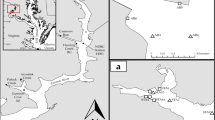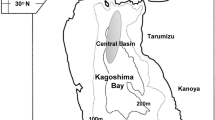Abstract
Shrimps are economically and ecologically very important, yet a lack of ageing techniques and hence unknown growth rates often impairs analytical assessments and management. A new method for the determination of in situ growth rates of shrimps is presented, based on dry weight condition. Since this index oscillates from low values directly after moult to highest values prior to moult in constantly feeding shrimp, the lowest observed pre-moult condition followed by a moult was introduced as a reference value to separate growing and starving individuals in field data. Experiments with Crangon crangon confirmed that (1) post-moult condition varies in a narrow physiologically optimal range, regardless of recent growth increments, and (2) dry weight condition prior to moult is closely related to the subsequent length increment. The method was applied to estimate growth increments from in situ dry weight condition data of C. crangon. The new method can easily be applied to other related species, since the required data can be obtained from very simple short-term experiments.






Similar content being viewed by others
References
Amara R, Paul C (2003) Seasonal pattern in the fish and epibenthic crustacean community of an intertidal zone with particular reference to the population dynamics of plaice and brown shrimp. Estuar Coast Shelf Sci 56:807–818
Atkinson A, Shreeve RS, Hirst AG, Rothery P, Tarling GA, Pond DW, Korb RE, Murphy EJ, Watkins JL (2006) Natural growth rates in Antarctic krill (Euphausia superba): II. Predictive models based on food, temperature, body length, sex, and maturity stage. Limnol Oceanogr 51:973–987
Berghahn R (1983) Untersuchungen an Plattfischen und Nordseegarnelen (Crangon crangon) im Eulitoral des Wattenmeeres nach dem Übergang zum Bodenleben. Helgoländer Meeresun 36:163–181
Campos J, Van der Veer H, Freitas V, Kooijman SALM (2010) Contributions of different generations of the brown shrimp Crangon crangon (L.) in the Dutch Wadden Sea to commercial fisheries: a dynamic energy budget approach. J Sea Res 62:106–113
Chang ES (1995) Physiological and biochemical changes during the molt cycle in decapod crustaceans: an overview. J Exp Mar Biol Ecol 193:1–14
Dalley R (1980) The survival and development of the shrimp Crangon crangon (L.), reared in the laboratory under non-circadian light-dark cycles. J Exp Mar Biol Ecol 47:101–112
Del Norte-Campos AGC, Temming A (1998) Population dynamics of the brown shrimp Crangon crangon L. in shallow areas of the German Wadden Sea. Fish Manag Ecol 5:303–322
Drach P (1939) Mue et cycle d’intermue chez les crustacés décapodes. Ann Inst Oceanogr 19:106–377
Evans S (1984) Energy budgets and predation impact of dominant epibenthic carnivores on a shallow soft bottom community at the Swedish west coast. Estuar Coast Shelf Sci 18:651–672
Galindo C, Gaxiola G, Cuzon G, Chiappa-Carrara X (2009) Physiological and biochemical variations during the molt cycle in Juvenile Litopenaeus vannamei under laboratory conditions. J Crust Biol 29:544–549
Gamito R, Cabral H (2003) Mortality of brown-shrimp discards from the beam trawl fishery in the Tagus estuary. Portugal Fish Res 63:423–427
Gillett R (2008) Gobal study of shrimp fisheries. FAO Document technique sur les peches. No. 475. FAO, Rome, p 331
Hufnagl M, Temming A (2011a) Growth rates of Crangon crangon (L.): length, temperature, sex and season dependence. Mar Ecol Prog Ser 435:141–155
Hufnagl M, Temming A (2011b) Growth rates of Crangon crangon (L.): meta-analysis and growth modelling. Mar Ecol Prog Ser 435:155–172
Hufnagl M, Temming A, Siegel V, Tulp I, Bolle L (2010a) Estimating total mortality and asymptotic length of Crangon crangon between 1955 and 2006. ICES J Mar Res 67:875–884
Hufnagl M, Temming A, Dänhardt A, Perger R (2010b) Is Crangon crangon (L. 1758, Decapoda, Caridea) food limited in the Wadden Sea? J Sea Res 64:386–400
Hume RI, Berlind A (1976) Heart and scaphognathite rate changes in a euryhaline crab, Carcinus maenas, exposed to dilute environmental medium. Biol Bull 150:241–254
ICES (2009) Report of the Working Group on crangon fisheries and life history. ICES Living Resources Committee, CM 2009/LRC:07
ICES (2011) Report of the Working Group on crangon fisheries and life history. ICES SCICOM Steering Group on Ecosystem Functions, CM 2011/SSGEF:11
Jansen S (2002) Das Räuber-Beutesystem juveniler Gadiden, Grundeln und Garnelen im Wattenmeer nördlich von Sylt. Dissertation, University of Hamburg, Hamburg
Janssen GM, Kuipers BR (1980) On tidal migration in the shrimp Crangon crangon. Neth J Sea Res 14:339–348
Koeller P, Savard L, Parsons DG, Fu C (2000) A precautionary approach to assessment and management of shrimp stocks in the Northwest Atlantic. J Northw Atl Fish Sci 27:235–246
Kuipers BR, Dapper R (1981) Production of Crangon crangon in the tidal zone of the Dutch Wadden Sea. Neth J Sea Res 15:33–53
Kuipers BR, Dapper R (1984) Nursery function of Wadden tidal flats for the brown shrimp Crangon crangon. Mar Ecol Prog Ser 17:171–181
Lockwood AP (1967) Aspects of the physiology of crustacea. University reviews in biology. W. H. Freeman and Company, San Francisco
Meixner R (1969) Wachstum, Häutung und Fortpflanzung von Crangon crangon (L.) bei Einzelaufzucht. Ber Dtsch Wiss Komm Meeresforsch 20:93–111
Mykles DL (1996) Crustaceans as a model for microgravity-induced muscle atrophy. Adv Space Res 17:201–204
Nicol S (2000) Understanding krill growth and aging: the contribution of experimental studies. Can J Fish Aquat Sci 57:168–177
Oh CW, Hartnoll RG (2000) Effects of food supply on the growth and survival of the common shrimp Crangon crangon (Linnaeus, 1758) (Decapoda, Caridea). Crustaceana 73:83–99
Passano LM (1960) Molting and its control. In: Waterman TH (ed) The physiology of Crustacea, vol 1. Academic Press, New York, pp 473–536
Pérez-Castañeda R, Defeo O (2002) Morphometric relationships of penaeid shrimps in a coastal lagoon: spatio-temporal variability and management implications. Estuaries 25:282–287
Quentin LB, Ross RM (1991) Behavioural and physiological characteristics of Antarctic krill Euphusia superba Dana. Am Zool 31:49–63
Quetin LB, Ross RM, Clarke A (1994) Krill energetics: seasonal and environmental aspects of the physiology of Euphausia superba. In: El-Sayed SZ (ed) Southern ocean ecology: the BIOMASS perspective. Cambridge University Press, Cambridge, pp 165–184
Redant F (1980) Population dynamics of brown shrimp (Crangon crangon) in the Belgian coastal waters, 2. Predation mortality. ICES C.M. 1980/K:33
Regnault M (1979) Ammonia excretion of the sand-shrimp Crangon crangon (L.) during the moult cycle. J Comp Physiol 133:199–204
Reid K (2001) Growth of Antarctic krill Euphausia superba at South Georgia. Mar Biol 138:57–62
Rey-Rassat C, Bonnet D, Irigoien X, Harris R, Head R, Carlotti F (2004) Is weight an important parameter when measuring copepod growth? J Exp Mar Biol Ecol 313:19–27
Robertson JD (1960) Ionic regulation in the crab Carcinus maenas (L.) in relation to the moulting cycle. Comp Biochem Physiol 1:183–212
Siebers D, Lucu C, Sperling KR, Eberlein K (1972) Kinetics of osmoregulation in the crab Carcinus maenas. Mar Biol 17:291–303
Skinner DM (1966) Breakdown and reformation of somatic muscle during the molt cycle of the land crab, Gecarcinus lateralis. J Exp Zool 163:115–123
Speck U, Urich K (1971) Quantitative Bedeutung der Reservestoffe für Chitinsynthese, Energiestoffwechsel und osmotische Vorgänge während der Häutung des Flusskrebses Orconectes limosus. Z Vgl Physiol 71:286–294
Tarling GA, Shreeve RS, Hirst AG, Atkinson A, Pond DW, Murphy EJ, Watkins JL (2006) Natural growth rates in Antarctic krill (Euphausia superba): I. Improving methodology and predicting intermoult period. Limnol Oceanogr 51:959–972
Taylor EW, Butler PJ, Alwassia A (1977) Effect of a decrease in salinity on respiration, osmoregulation and activity in shore crab, Carcinus maenas, at different acclimation temperatures. J Comp Physiol 119:155–170
Temming A, Damm U (2002) Life cycle of Crangon crangon in the North Sea: a simulation of the timing of recruitment as a function of the seasonal temperature signal. Fish Oceanogr 11:45–58
Tetard A (1985) Elements sur la croissance de la crevette grise, Crangon crangon (L.), en Manche-est et Sud mer du Nord. ICES C.M 1985/K:17
Tiews K (1954) Die biologischen Grundlagen der Büsumer Garnelenfischerei. Ber Dtsch Wiss Komm Meeresforsch 3:235–269
Tiews K (1969) Die Markierung von 60000 Nordseegarnelen Crangon crangon (L.) und ihre Ergebnisse. Arch Fischereiwiss 20:33–41
Tiews K (1978) The predator prey relationship between fish populations and the stock of brown shrimp (Crangon crangon L.) in German coastal waters. Rapp Proces 172:250–258
Wilcox JR, Jeffries HP (1976) Hydration in the sand shrimp Crangon septemspinosa: relation to diet. Biol Bull Mar Biol Lab Woods Hole 150:522–530
Acknowledgments
The authors thank Marc Hufnagl and Jens-Peter Hermann of the Institute for Hydrobiology and Fisheries science for stimulating scientific discussions of the approach and logistical support and an anonymous reviewer for very constructive comments.
Author information
Authors and Affiliations
Corresponding author
Additional information
Communicated by X. Irigoyen.
Appendix
Appendix
Equation 5 can be further simplified if the dry weight condition before moulting (C1−E ) is introduced.
Now in Eq. 5, the fraction is expanded with L1b and Eq. a1 is applied to simplify
Equation a3 was used to describe the laboratory-based relationship between pre-moult condition C1−E and the subsequently realised increment (INC). Here, a condition of C1−E = 1 corresponds to an increment of INC = 0.
Rights and permissions
About this article
Cite this article
Perger, R., Temming, A. A new method to determine in situ growth rates of decapod shrimp: a case study with brown shrimp Crangon crangon . Mar Biol 159, 1209–1222 (2012). https://doi.org/10.1007/s00227-012-1901-1
Received:
Accepted:
Published:
Issue Date:
DOI: https://doi.org/10.1007/s00227-012-1901-1




